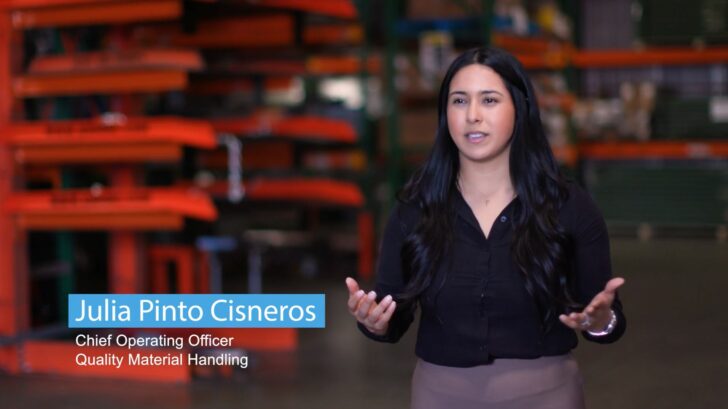When Hector and Brenda Pinto’s former employer had difficulty meeting payroll in 1991, Hector made the bold decision that the two needed to quit. Arriving at home that day, he set up a card table and began calling his customers. Although he wasn’t working for the company any longer, he told his customers he would help with anything they needed.
By the week’s end, Hector landed a $16,000 contract that launched Quality Material Handling Inc. Starting his own business wasn’t his initial intention, and he quickly enlisted Brenda as the second employee. Anyone who knows Hector and his strong work ethic wasn’t surprised at the turn of events.
After all, Hector, who emigrated from a small town in Honduras when he was 14, has always been a go-getter. His hardworking trait started when he was a small child selling unsold fruit and vegetables from the family stand to his neighbors at a discount so it wouldn’t spoil.
Now 30 years later, Quality Material Handling or QMH is making its own operations more efficient. Located in Rancho Cucamonga, California, QMH is committed to providing end-to-end solutions for companies with distribution, logistic and warehousing needs. From permit approval management to full-service execution from the ground up, QMH delivers unique solutions providing distinct value in record time
“Quality Material Handling specializes in warehouse support solutions,” Hector says. “We have an entire team that does sprinkler systems, racking systems, permits, dock equipment, and our specialty is providing what others don’t.”
The company is family run: As CEO, Hector heads sales, Brenda, CFO, heads up finance, and daughter Julia Pinto Cisneros, COO, oversees operations. Her husband Ben Cisneros is the company’s Sales Manager. The company ran accounting on legacy Sage 100 on-premises that hadn’t been upgraded. Outside of the legacy system, they used paper and excel spreadsheets to track inventory, invoices, and everything else.
“The downside to Sage was it felt like I was dealing with a hard brick,” says Julia. “I was trying to chisel away at a brick to try to get it to do what I wanted.” Most transactions were accomplished through email, scheduling with Outlook, and multiple spreadsheets tracked everything else. “It was a lot of manual, double-entry, which was error-prone and wasted a lot of time.”
The accounting department was months behind. “It was very difficult to get a financial picture of where we were at in the business because we just didn’t have all of the information in the system at month end, and it just took me so long to double check that it was accurate,” says Brenda.
In addition, Hector, the lead salesman, refused to use Sage because it wasn’t user-friendly. “I never found Sage 100 easy to work with,” he says. “I’m not very savvy with computers and technology. I would rather use a piece of paper than do something in the complicated system.”
“He went 19 years never using the software,” adds Julia. “He didn’t even have a log-in.”
Without Cloud ERP ‘We were out of commission’
When the Internet went down for an entire day in a previous location, Julia decided they needed a better financial software solution. “We didn’t have internet or phones because we were VOIP or email,” she says. “Without a cloud-based ERP, we were out of commission.”
“Sage 100 just wasn’t meant for our business,” Julia adds. “We had some add-ons, like Bill of Materials, and we also tried adding on a manufacturing module and project management. We tried implementing them, but it was just too complicated.”
QMH maxed out its Sage user licenses, and the legacy software ran very slow, she says. QMH purchased 13 seat licenses, so they were constantly managing who could work in Sage, she says. Because it ran on an in-house aging server, no one could use it outside the office.
“No one really outside of accounting benefited,” Julia says. “I couldn’t manage what was going on. To run a weekly operational meeting would take me a couple of hours just to export information, color code it, and figure out where orders sat. I couldn’t see a pick sheet, just open orders; I couldn’t see if something was backordered or whether it was invoiced or not.”
Managing inventory was a nightmare, adds Leilani Hernandez, warehouse coordinator. “With Sage, it was very hard, I would have to write things down to remember something, and when I couldn’t remember, I would have to go back to the item in the warehouse. The inventory wasn’t accurate at all. We always had to double check everything.”
 Canada (English)
Canada (English)
 Colombia
Colombia
 Caribbean and Puerto Rico
Caribbean and Puerto Rico
 Ecuador
Ecuador
 India
India
 Indonesia
Indonesia
 Ireland
Ireland
 Malaysia
Malaysia
 Mexico
Mexico
 Panama
Panama
 Peru
Peru
 Philippines
Philippines
 Singapore
Singapore
 South Africa
South Africa
 Sri Lanka
Sri Lanka
 Thailand
Thailand
 United Kingdom
United Kingdom
 United States
United States








